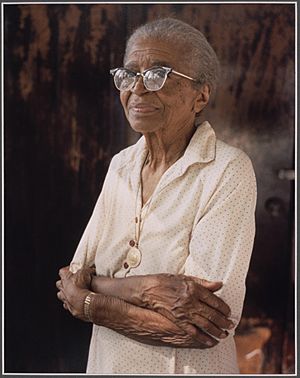Eunice Rivers Laurie facts for kids
Quick facts for kids
Eunice Verdell Rivers Laurie
|
|
|---|---|
 |
|
| Born | November 12, 1899 Georgia, U.S
|
| Died | August 28, 1986 (aged 86) |
| Nationality | American |
| Other names | Eunice Rivers |
| Occupation | Nurse |
| Known for | Medical study coordinator |
| Spouse(s) | Julius Laurie |
Eunice Verdell Rivers Laurie (1899 – 1986) was an African American nurse who worked in the state of Alabama.
Early life and education
Born into a farming family in rural Georgia in 1899, Eunice Verdell Rivers was the oldest of three daughters. She was born at a time and place in which race relations in the United States were at their lowest point. Originating from a poor, working-class family, Rivers' education allowed her access to middle-class life. Her mother, who died when Rivers was 15 years old, encouraged her to attend school from a young age. She told Rivers to “get a good education, so (she) wouldn't have to work in the fields so hard.” Her father, also a proponent of education, encouraged her to become a nurse. He wanted all three of his daughters to have adequate schooling, working long hours at the sawmill to help finance their studies.
Rivers followed her father's advice. She attended Tuskegee Institute's School of Nursing and graduated in 1922. Established in 1881 by Booker T. Washington, the Tuskegee Institute was a leading black educational institution in Alabama. After graduating from the Tuskegee School of Nursing, Rivers worked in the public health sector from 1923 until well after her retirement in 1965.
Career
Beginning in January 1923, Rivers worked for the Tuskegee Institute Movable School, which "provided adult education programs in agriculture, home economics, and health." As a result of this traveling work, she became a trusted health authority for African-American farming families in the area around Tuskegee, Alabama. As part of the school, she provided various public health services to African-American men and women in rural Alabama. She supplied adult education programs in agriculture, home economics, and health. She also helped spread health education messages, such as improvements in sanitation, ventilation, and cleanliness, to rural women. She informed the public, especially women, about specific diseases, including malaria and typhoid fever. She taught them how to make bandages from old clothes, care for sickly patients, and take temperatures. For the children, she gave dental hygiene lectures and supplied tubes of Colgate toothpaste donated by the company. Further, her public health work with men concentrated on social hygiene.
In her work with the Movable School, Rivers was technically an employee of the Alabama Bureau of Child Welfare. Beginning in 1926, the state transferred her to working with the Bureau of Vital Statistics, where her projects included improving birth and death registration; regulating and training midwives; and reducing infant mortality. She was instrumental in creating a system that tracked the number of births and deaths in the state of Alabama. She also helped to regulate the lay midwifery and lower infant mortality rates. As an aside, she continued to work with the Movable School, traveling around Alabama but this time focusing on pregnant women and midwives. While at the Movable School, she was constantly integrated in the community, visiting patients throughout the states’ counties. In her first year, she visited over 20 counties and was noted for tending to 1,100 people during a particularly busy month.
This work also involved substantial amounts of travel to interact with African Americans in rural Alabama.
Impact on race relations
Rivers lived and worked her entire adult life in Alabama. This was a state in which race was a dominant factor of southern society. As an African-American in the deep South during the era of Jim Crow laws, she was expected to accept demands by all whites, especially her supervising physicians. However, her life paints a picture of defiance against segregation. She became one of the first African-Americans to be employed by the United States Public Health System (PHS), thus paving the way for other people of color in this area of service. Rivers started working at the PHS during a time in which the U.S. was in the worst economic depression in its history.
Her life's work was an example of greater opportunities for African-Americans, especially in the South. Her work ethic, care for patients, and exceptional nursing abilities earned her the respect of her white supervisors and other health professionals. During an era when she was expected to follow orders without question, she had countless letters of support praising her professional capability and excellent interpersonal skills. As an African-American nurse who played a critical role in scientific experiments and patient care, Rivers helped expand the impact of these groups of people in medicine. Later, she became the third annual recipient of the Oveta Culp Hobby Award, the highest award the Department of Health, Education, and Welfare could grant an employee.
Later life and death
In 1977, Rivers was interviewed for the Black Women Oral History Project.
She died in 1986.

